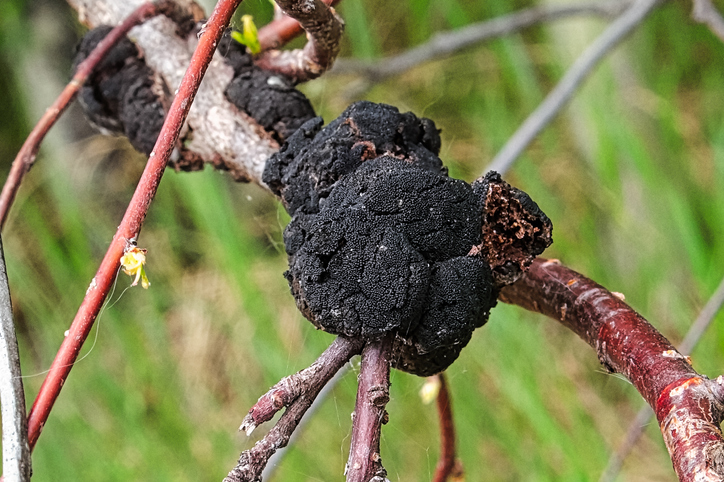The black fungus or the black knot is a common fungal disease that attacks trees, especially the plum and cherry trees.

Black knot disease is easy to identify and diagnose. Trees affected by black fungus gradually appear swollen, hard, and black knots appear on their branches and twigs, hence the name black knots. If left untreated, the fungus will expand, grow larger, and spread to the tree’s stem.
This fungal disease spreads during spring as the wind easily transports the spores of the black knot. The spore then lands on a new susceptible tree where it germinates. The germinated spores release a chemical that causes trees to grow extra plant cells, resulting in the swollen black knots.
Although the disease affects mostly wild trees, it can spread to your trees too if you don’t monitor and maintain them well.
Symptoms of Black Knot
As said earlier, one of the most visible signs that indicate that the disease has attacked your tree is the black knots that appear on the branches. Other symptoms include;
- Infected branches may tilt to one side
- In some cases, leaves wilt, turn brown, and eventually fall off
- In severe cases, the black knots spread to the trunk
- Black knots, when cracked may produce a sticky liquid
- Wood rot may occur
Will Black Knot Kill My Tree?
If left untreated, yes, a black knot will spread through your tree, which may eventually lead to its death. Black fungal should be treated as a chronic disease because even if it doesn’t kill the tree, it will affect the growth.
How to Manage Black Knot
Buy Resistant Tress
There are black-knot resistant trees that are less susceptible to the disease. Purchasing these resistant trees is the best way to prevent black knot disease.
Prune
Another way to get rid of black knot is pruning. Pruning involves cutting off the branches, twigs, or stems that show signs of the disease. It is essential to cut about 2-4 inches below the growth to remove all infected parts.
The cut-off part should be burned or disposed of properly because they can still infect susceptible trees. The pruning tools should also be well disinfected before using it on other trees to avoid spreading the disease.
Use Fungicide
Another effective way to prevent or get rid of black fungus is by using a fungicide. Before fungicide can be applied, you have to remove existing black knots.
Also, fungicide is best applied in dry weather when the temperature is above 60 degrees Fahrenheit. It’s important to strictly follow the instructions of the fungicide spray and respray at regular intervals.
Which Fungicide Can Be Used to Treat Black Rot?
Fungicides vary in their effectiveness. Therefore, it is imperative to use a fungicide to manage the black knots and limit the primary infection in your tree.
The fungicide should have active ingredients like Captan, Chlorothalonil, Lime Sulfur, Thiophanate-methyl for it to be effective against black fungus. Examples of such protectant fungicides that are very effective against black fungus are Mancozeb and Ziram.
Speak With a Professional
You can consider hiring a professional for the pruning activities and fungicide applications for effective results against Black Fungus disease. If you notice your tree has black knot disease, contact Nelson Tree Specialists today to begin a treatment plan that will save your trees.
